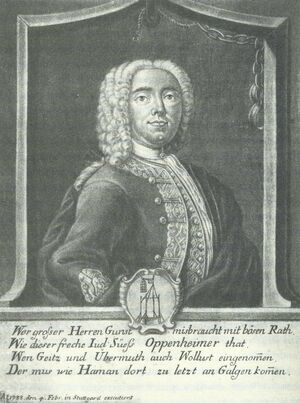يوزف زوس أوپنهايمر
يوزف زوس أوپنهايمر | |
|---|---|
Joseph Süß Oppenheimer | |
 | |
| وُلِدَ | 1698/1699 |
| توفي | فبراير 4, 1738 (aged 39) |
| المهنة | يهودي البلاط |
يوزف زوس أوپنهايمر (Joseph Süß Oppenheimer ؛ 1698؟ – 4 فبراير 1738) كان مصرفياً يهودياً ألمانياً و يهودي البلاط للدوق كارل ألكسندر من ڤورتمبرگ في شتوتگارت. طوال عمله، صنع أوپنهايمر الكثير من الأعداء الأقوياء، بعضهم تآمر لإعتقاله وإعدامه بعد وفاة كارل ألكسندر.
في القرون التي تلت إعدامه، قصة صعود وسقوط أوپنهايمر عولجت في عملين أدبيين بارزين، وألهمت محنته فيلمين، منهما الانتاج المعادي للسامية اليهودي زوس Jud Süß، المُنتَج في ألمانيا النازية]] في 1940، والذي تسبب في محاكمة شهيرة بعد الحرب.[1]
سيرته المهنية
وُلِد أوپنهايمر في هايدلبرگ لجابي ضرائب يهودي وزوجته. The father died early, and the exact whereabouts of Joseph Süß in the following years are not certain. By the 1720s, however, Oppenheimer was already working as a court Jew in Mannheim, Darmstadt, and finally Frankfurt am Main, where he was introduced to Karl Alexander, the future دوق ڤورتمبرگ, in 1732. When Karl Alexander ascended the throne in the following year, Oppenheimer served as his chief financial adviser.
الاعتقال والمحاكمة والإعدام
حين مات حاميه، كارل ألكسندر، فجأة في 12 مارس 1737، اِعتُقِل أوپنهايمر واِتـُهِم بعدة جرائم، منها التزوير والاختلاس وتقاضي الرشوة والخيانة العظمى وتدنيس الديانة الپروتستانتية وإقامة علاقات جنسية مع نساء "مسيحيات". While some Jews tried to help him during the trial, others gave incriminatory testimonies against him. The charge of lechery was dropped in order to protect reputable women.
After the heavily publicized trial, Oppenheimer was sentenced to death, without naming any specific crime. When his jailers asked that he convert to Christianity, he refused.
Joseph Süß Oppenheimer was led to the gallows on February 4, 1738, and given a final chance to convert to Christianity, which he refused to do. He was throttled,[2] with his last words reportedly being the Jewish prayer, "Hear, O Israel: the Lord is our God, the Lord is one".
This makes Oppenheimer one of the best-known victims of an anti-Semitic judicial murder.
The case records were then declared secret until 1918. His corpse was gibbeted in a cage that hung outside of Stuttgart in the Pragsattel district for six years until the inauguration of Karl Eugen, Duke of Württemberg, who in his first act as ruler permitted the burial of his corpse below the gallows.
في الأدب والفن والأفلام
The story of Joseph Süß Oppenheimer was the subject of a number of literary and dramatic treatments over the course of the past two centuries.[3] The earliest of these having been Wilhelm Hauff's 1827 novella titled Jud Süß.[4] The most successful literary adaptation was Lion Feuchtwanger's 1925 novel titled Jud Süß based on a play that he had written in 1916 though never performed and subsequently withdrawn by Feuchtwanger.
Ashley Dukes and Paul Kornfeld also wrote dramatic adaptations of the Feuchtwanger novel. In 1934, Lothar Mendes directed a film adaptation of the novel in which Süß was portrayed by actor Conrad Veidt.[5] An anti-semitic Nazi propaganda film titled Jud Süß was made in 1940 by Veit Harlan, in which Süß was portrayed by actor Ferdinand Marian.
In the 1990s, the German sculptor Angela Laich created a sculpture devoted to Joseph Süß Oppenheimer as well as illustrations for Hellmut G. Haasis's biography.
In 2016 the movie Norman: The Moderate Rise and Tragic Fall of a New York Fixer was released, loosely inspired by Oppenheimer's life, starring Richard Gere.
سِيَر
Shortly after Feuchtwanger's novel was published, Selma Stern published a biography of Oppenheimer titled Jud Süß: Ein Betrag zur deutschen und zur jüdischen Geschichte. More recently, Hellmut G. Haasis published a biography titled Joseph Süß Oppenheimer, genannt Jud Süß: Finanzier, Freidenker, Justizopfer. It is still the standard work on the topic. In 2017, Yair Mintzker, a history professor at Princeton University, published a new account of Oppenheimer's trial, The Many Deaths of Jew Süss, which is the most comprehensive treatment of Oppenheimer's trial available in English.
المراجع
- ^ Mintzker, Yair (2017). The Many Deaths of Jew Süss : The Notorious Trial and Execution of an Eighteenth-Century Court Jew. Princeton: Princeton University Press. ISBN 9781400887804.
- ^ Not hanged, the gibbet was only used to hang the cage where his body was placed.
- ^ Tegel, Susan (2011). The Jew Süss : His Life and Afterlife in Legend, Literature and Film. London: Continuum. ISBN 9781847250179.
- ^ Chase, Jefferson S. (1998). "The Wandering Court Jew and the Hand of God: Wilhelm Hauff's 'Jud Süss' as Historical Fiction". Modern Language Review. 93 (3): 724–740. doi:10.2307/3736493. JSTOR 3736493.
- ^ B. Haines; S. Parker (March 17, 2010). AESTHETICS AND POLITICS IN MODERN GERMAN CULTURE. Peter Lang. ISBN 978-3-03911-355-2. Retrieved October 27, 2011.
